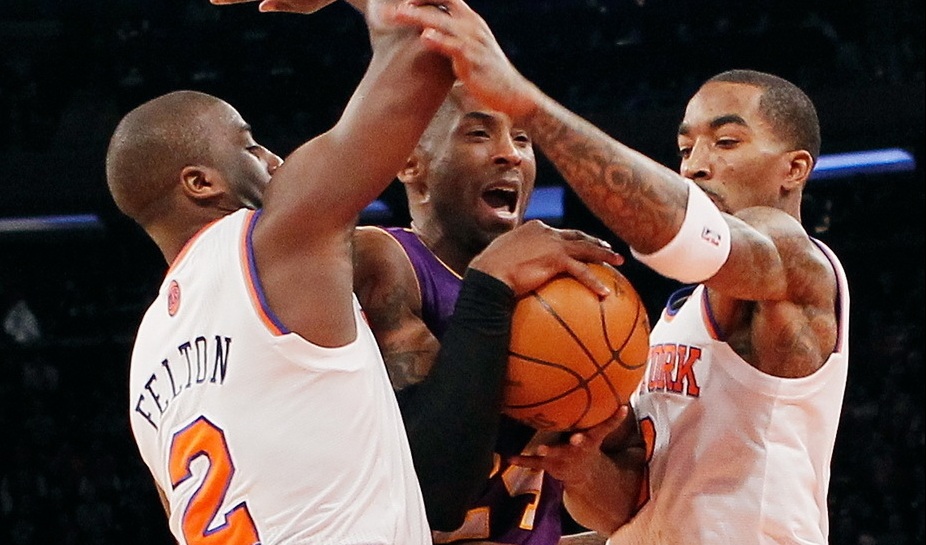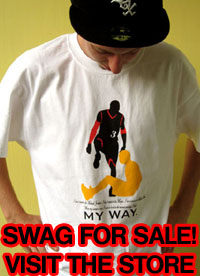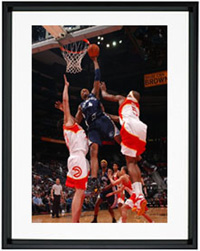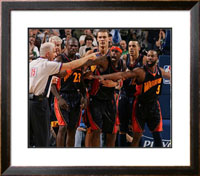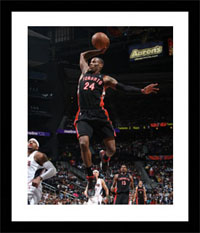One great quarter… that’s all it takes to beat the Lakers these days. Led by Carmelo Anthony and his 22 points, the Knicks set Madison Square ablaze in the early going with a season-best 41 points in the first 12 minutes. Melo was scorching-hot from downtown; he connected on his first three-pointer just 37 seconds into the game, and proceeded to pull up and knock down two more prior the initial TV timeout. He finished the period a remarkable 8-9 from the floor and 3-3 from the stripe, highlighting the show with a driving two-handed crush over Jordan Hill. Though Anthony himself didn’t have any assists during the onslaught, the Knicks shared the ball to the beautiful tune of eight dimes, and the hot hand was contagious — New York missed just 6 shots on 23 attempts (74%).
As the Knicks sent the Garden crowd into a frenzy with this first-quarter barrage, one of the Lakers’ many problems became quite evident: they’re slow. The Lakers are slow to contest three-point shooters (opponent 3FG%: 15th), slow in the open court (opponent fast-break points: 29th), and slow moving laterally on defense (opponent points in the paint: 22nd). I believe their lack of speed could be made up for, at least partially, by improved effort and decision making, but Kobe Bryant had a point when he joked that he’s one of the fastest players on the team despite being “like 50.” This is an aging roster that lacks athleticism from top to bottom, and it shows when Carmelo Anthony blows by Metta World Peace with the greatest of ease. That never would’ve happened to Ron Artest, but Ron Artest isn’t walking through that door. Neither is Antawn Jamison. Hell, there’s no guarantee that Pau Gasol and Steve Nash are going to be the players they’ve been in the past.
The Knicks began to take their foot off the gas in the second quarter. They continued to shoot well from the outside, but they also focused on individual offensive ideas rather than the collective attack that got them their massive lead. A series of isolations led to an extended slump, and New York went to the break with 68 points. That’s a ton, obviously, but keep in mind that they already had 55 of them with eight minutes to go until the half, and 60 with over five minutes left.
The Knicks never did rediscover their first-quarter magic. They played plenty well enough to win the game — the 116-107 final makes this thing out to be much more competitive than it was — and were able to score a respectable 48 in the second half despite losing Carmelo Anthony to a sprained left ankle (don’t worry, he’s gonna be fine) he suffered when he landed awkwardly after being fouled by Dwight Howard. Melo left about midway through the third, and athough he’d cooled off a little bit, he still appeared to be well on his way to a 40+ night (finished with 30 on 10-15).
The closest the Lakers ever got was six. That was with a minute and a half to go, at which point Metta World Peace had just converted a three-point play. At that very moment, the purple & gold really did appear to be within striking distance… but the uncertainty was extremely short lived. On the ensuing Knicks possession, Tyson Chandler back-tapped a pair of missed shots, allowing New York to run the clock all the way down to 18 seconds. Remarkably, Chandler had done the same exact thing to interrupt the Lakers’ second-most-threatening run just a few minutes earlier. You wouldn’t know it by looking at the box score, but Tyson’s four rebounds actually translated into a massive night on the glass. With some offensive help from JR Smith (who backed up his tweeting and dropped 10 of his 18 in the fourth), Chandler’s Knicks never did allow the Lakers to get within a single basket, let alone lead (it was a wire-to-wire victory).
Early in the game, it was LA’s lack of speed, athleticism, and defensive energy that was exposed. Later on, their offensive ineptitude came to the forefront. As they tend to, the Lakers looked to Kobe Bryant once they’d dug themselves a 20-point hole. Bryant had a solid outing — 30 points on 24 shots — but his team’s collective offensive effort wasn’t any better for it; the Lakers recorded just 13 assists to 13 turnovers and shot an unimpressive 41.7% from the floor. With a game plan that appears to do little more than alternate Dwight Howard post-ups and Kobe Bryant isos, the Lakers currently have an offense that makes that of the Sacramento Kings look lively. Only the Kings have a worse assist-to-turnover ratio, and no team coughs the ball up as much as Los Angeles does on a per-possession basis. All these turnovers obviously lead to transition play, one of the major Laker weaknesses I discussed in the second paragraph of this article.
Clearly, the Lakers have a daunting number of issues to deal with right now. What worries me more than anything, though, is the nature of these issues. While Steve Nash will certainly bring some added motion of the halfcourt offense, he figures to be about as effective as Derek Fisher in staying in front of his man, and Dwight Howard doesn’t care to take his shooting tips to heart. As for Pau Gasol, his length and versatility ought to improve the team at both ends of the floor, but he’s always moved like a sloth, and it seems as though he’s been in a mental funk for quite some time now.
My point here is that this team appears to have some serious problems that time and coaching alone won’t solve. Even when healthy, these guys have no depth or athleticism… and it’s unclear whether or not they’ll mesh into one cohesive unit. With the losses piling up, it becomes harder and harder to assume that these 9-14 Lakers will drastically turn it around. While I certainly expect improvement, it’s a long way from where they are now to championship contention. I’m beginning to wonder if — as presently constructed — the Lakers are capable of such success.

